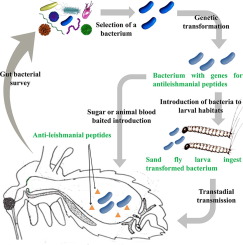当前位置:
X-MOL 学术
›
Biol. Control
›
论文详情
Our official English website, www.x-mol.net, welcomes your
feedback! (Note: you will need to create a separate account there.)
Recent developments and future directions in the paratransgenesis based control of Leishmania transmission
Biological Control ( IF 3.7 ) Pub Date : 2020-06-01 , DOI: 10.1016/j.biocontrol.2020.104260 Tharaka Wijerathna , Samadhi Gunathunga , Nayana Gunathilaka
Biological Control ( IF 3.7 ) Pub Date : 2020-06-01 , DOI: 10.1016/j.biocontrol.2020.104260 Tharaka Wijerathna , Samadhi Gunathunga , Nayana Gunathilaka

|
Abstract Vector-borne diseases are one of the main concerns regarding global health. Among these, leishmaniasis stands as one of the most serious issues. This disease is transmitted via the bite of female phlebotomine sand flies. Due to the drawbacks such as the development of resistance associated with conventional vector control methods, paratransgenesis has become more popular in the recent past. A range of bacteria inhabit the gut of different species of sand flies. Bacillus subtilis, B. megaterium, and Enterobacter cloacae dissolvens are some of the common bacteria with ideal characteristics for this technique. Among the large number of natural anti-microbial peptides (AMPs) recovered from animals, DS hypo-01, Phylloseptin-1 and melittin are found to be the most effective. Hybrids of Cecropin A and melittin such as CA(1–8)M(1–18), D-CA(1–8)M(1–18) and N-Ac-CA(1–8)M(1–18) are also suitable candidates. Use of peptides initially released in an inactive form to activate upon exposure to a specific molecule is a potential solution for the lower specificity of AMPs. Single chain antibodies on the other hand, have high specificity, but effectiveness is lower than AMPs. The genetic transformation of the selected bacteria and the generation of paratransgenic sand flies through transtadial transmission are feasible under laboratory conditions. Safe delivery techniques such as microencapsulation are being tested to increase the specificity reducing environmental issues. Nevertheless, extensive studies with more practical approaches are required before applying this technique in the field.
中文翻译:

基于副转基因的利什曼原虫传播控制的最新进展和未来方向
摘要 媒介传播疾病是全球健康的主要问题之一。其中,利什曼病是最严重的问题之一。这种疾病是通过雌性白蛉的叮咬传播的。由于诸如与传统载体控制方法相关的抗性的发展等缺点,近来准转基因变得更加流行。一系列细菌栖息在不同种类的沙蝇的肠道中。枯草芽孢杆菌、巨大芽孢杆菌和阴沟肠杆菌溶解物是具有该技术理想特性的一些常见细菌。在从动物身上回收的大量天然抗微生物肽 (AMP) 中,发现 DS hypo-01、Phylloseptin-1 和蜂毒肽最有效。天蚕素 A 和蜂毒肽的杂交体,例如 CA(1-8)M(1-18),D-CA(1-8)M(1-18) 和 N-Ac-CA(1-8)M(1-18) 也是合适的候选者。使用最初以非活性形式释放的肽在暴露于特定分子时激活是降低 AMP 特异性的潜在解决方案。另一方面,单链抗体具有高特异性,但有效性低于 AMP。在实验室条件下,选定细菌的遗传转化和通过跨区传播产生准转基因白蛉是可行的。正在测试安全递送技术,例如微囊化,以增加特异性,减少环境问题。然而,在将该技术应用于该领域之前,需要对更实用的方法进行广泛的研究。使用最初以非活性形式释放的肽在暴露于特定分子时激活是降低 AMP 特异性的潜在解决方案。另一方面,单链抗体具有高特异性,但有效性低于 AMP。在实验室条件下,选定细菌的遗传转化和通过跨区传播产生准转基因白蛉是可行的。正在测试安全递送技术,例如微囊化,以增加特异性,减少环境问题。然而,在将该技术应用于该领域之前,需要使用更实用的方法进行广泛的研究。使用最初以非活性形式释放的肽在暴露于特定分子时激活是降低 AMP 特异性的潜在解决方案。另一方面,单链抗体具有高特异性,但有效性低于 AMP。在实验室条件下,选定细菌的遗传转化和通过跨区传播产生准转基因白蛉是可行的。正在测试安全递送技术,例如微囊化,以增加特异性,减少环境问题。然而,在将该技术应用于该领域之前,需要对更实用的方法进行广泛的研究。具有高特异性,但有效性低于 AMP。在实验室条件下,选定细菌的遗传转化和通过跨区传播产生准转基因白蛉是可行的。正在测试安全递送技术,例如微囊化,以增加特异性,减少环境问题。然而,在将该技术应用于该领域之前,需要对更实用的方法进行广泛的研究。具有高特异性,但有效性低于 AMP。在实验室条件下,选定细菌的遗传转化和通过跨区传播产生准转基因白蛉是可行的。正在测试安全递送技术,例如微囊化,以增加特异性,减少环境问题。然而,在将该技术应用于该领域之前,需要使用更实用的方法进行广泛的研究。
更新日期:2020-06-01
中文翻译:

基于副转基因的利什曼原虫传播控制的最新进展和未来方向
摘要 媒介传播疾病是全球健康的主要问题之一。其中,利什曼病是最严重的问题之一。这种疾病是通过雌性白蛉的叮咬传播的。由于诸如与传统载体控制方法相关的抗性的发展等缺点,近来准转基因变得更加流行。一系列细菌栖息在不同种类的沙蝇的肠道中。枯草芽孢杆菌、巨大芽孢杆菌和阴沟肠杆菌溶解物是具有该技术理想特性的一些常见细菌。在从动物身上回收的大量天然抗微生物肽 (AMP) 中,发现 DS hypo-01、Phylloseptin-1 和蜂毒肽最有效。天蚕素 A 和蜂毒肽的杂交体,例如 CA(1-8)M(1-18),D-CA(1-8)M(1-18) 和 N-Ac-CA(1-8)M(1-18) 也是合适的候选者。使用最初以非活性形式释放的肽在暴露于特定分子时激活是降低 AMP 特异性的潜在解决方案。另一方面,单链抗体具有高特异性,但有效性低于 AMP。在实验室条件下,选定细菌的遗传转化和通过跨区传播产生准转基因白蛉是可行的。正在测试安全递送技术,例如微囊化,以增加特异性,减少环境问题。然而,在将该技术应用于该领域之前,需要对更实用的方法进行广泛的研究。使用最初以非活性形式释放的肽在暴露于特定分子时激活是降低 AMP 特异性的潜在解决方案。另一方面,单链抗体具有高特异性,但有效性低于 AMP。在实验室条件下,选定细菌的遗传转化和通过跨区传播产生准转基因白蛉是可行的。正在测试安全递送技术,例如微囊化,以增加特异性,减少环境问题。然而,在将该技术应用于该领域之前,需要使用更实用的方法进行广泛的研究。使用最初以非活性形式释放的肽在暴露于特定分子时激活是降低 AMP 特异性的潜在解决方案。另一方面,单链抗体具有高特异性,但有效性低于 AMP。在实验室条件下,选定细菌的遗传转化和通过跨区传播产生准转基因白蛉是可行的。正在测试安全递送技术,例如微囊化,以增加特异性,减少环境问题。然而,在将该技术应用于该领域之前,需要对更实用的方法进行广泛的研究。具有高特异性,但有效性低于 AMP。在实验室条件下,选定细菌的遗传转化和通过跨区传播产生准转基因白蛉是可行的。正在测试安全递送技术,例如微囊化,以增加特异性,减少环境问题。然而,在将该技术应用于该领域之前,需要对更实用的方法进行广泛的研究。具有高特异性,但有效性低于 AMP。在实验室条件下,选定细菌的遗传转化和通过跨区传播产生准转基因白蛉是可行的。正在测试安全递送技术,例如微囊化,以增加特异性,减少环境问题。然而,在将该技术应用于该领域之前,需要使用更实用的方法进行广泛的研究。











































 京公网安备 11010802027423号
京公网安备 11010802027423号